Acknowledgement
The 100th anniversary of Eagles Auditorium will be in 2025. While 100 years seems quite old for a young city, Seattle was well-established by the
time the Auditorium was built. As such, there was considerable pre-history at the site.
The site, like all of Seattle, lies on the historic homelands of the Duwamish tribe of the Seattle.
We must always acknowledge that the land where Eagles Auditorium stands is part of the historic land of the Duwamish Tribe,
The People of the Inside, dxʷdəwʔabš, part of the Salish People, on the shore of the Salish Sea.
The Duwamish have lived in this area for literally thousands of years, well before the arrival of the
Europeans, and live here to this day. The Duwamish, as their name implies, were centered on
the Duwamish river. It's hard to imagine what an idyllic setting this must have been, with mudflats protected from the worst of the weather
and rich in fish. Now, it's a polluted industrial wasteland, one of the grimmest spots in Seattle. Not only is it a site of ecological
devastation, it is also an insult to memory of all those that lived on this land before.
John W. Denny
Enter the Denny party. One of Seattle's founders, Arthur Denny, led a group of Eurpoean settlers who arrived in West Seattle in November of 1851.
They established themselves initially at what is now Alki Point.
Actually, a few months earlier, Arthur's brother David had arrived and settled in the Duwamish area, which was occupied by native people.
By most accounts relations between the native people and the settlers were decent, at least by the standards of the day.
Of course, when the time came to sign treaties and formalize the agreements, the Europeans reverted to being predatory, and
seized the land with little regard for oral promises made to the natives.
Regardless, the growing town was succesful enough that in 1866, David's son, John W. Denny, arriving overland from Portland, settled in the location where
Eagles Auditorium now stands. He owned a large white house on the property, but stayed for but a few years. While he lived there, the
land was used as a cider orchard. The cider mill is subject of a 1964 news story. John passed in 1923, subject of this obituary from the Seattle Times.
The Denny Cider Press
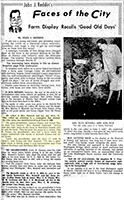
Sun, Jan 26, 1964 Seattle Times p. 23
John W. Denny Obiturary

Sat, Mar 03, 1923 Seattle Times p. 4
Environs
Fortunately, the entire area was far enough away from the core of the city when the famouse "Great Fire" of June 6, 1889 destroyed much of the historic
core. But neglect, urban redevelopment and time evenutally took its toll on most of the buildings that originally surrounded Eagles Auditorium site.
Newly built at the time of the Great Fire was the 1899 Unitarian church down the block from the 7th & Union corner, essentially where the Ackerly Forum is today,
so actually part of the Eagles Auditorium footprint. The Unitarians didn't stay long, opening their Boylston home in 1906. And the building itself was torn down
only 25 years after construction, to make room for Eagles Auditorium.
Directly across from Eagles Auditorium was the Wilhard Hotel, at 707 Union Street, currently home to One Union Square. The building stood until
It was eventually converted to low-income housing before being razed in 1972 to become a parking lot. This older photo was from the famous photographer
Asahel Curtis, brother of the more well-known Edward Curtis, but a photographic star in his own right.
Where the Sheraton currently sits, the Seventh Ave Apartments stood until it burned in 1971, causing 12 deaths. It was part of a spate of fires in
rundown Seattle hotels during the early 1970s. Over the course of 6 years, 4 hotels burned, killing a total 35 people.
Hotel Wilhard
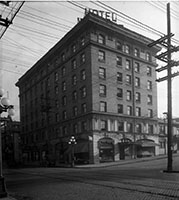
Asahel Curtis
Demolition of Hotel Wilhard
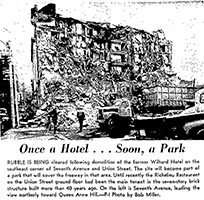
Fri, Nov 24, 1972 Seattle Post Intelligencer p. 20
Dreamland Pavillion
Before Eagles Auditorium was built on the site, it was occupied by Dreamland Rink (later called Dreamland Dance Hall), an arched wooden structure,
surrounded by a fortress-like facade. A sign announcing the building can be seen on the right of the photo of the Unitarian church in the previous
section. Besides being a roller rink and a dance hall, Dreamland was home to a number of progressive causes and lectures, including
Emma Goldman appearing in 1907 after having been implicated and arrested (with little or no evidence) in the assassination of President William McKinley, in 1901. And Socialist
Party candidate Eugene V. Debs spoke there in 1908. Also in 1908, Dreamland was the sight of the first car show in Seattle. Eventually, the Eagles acquired this building, and the Dreamland Dance Hall cabaret moved
down by Pioneer Square. At that location, the owners had a running battle with city government over licensing and concern that young women were hustling suitors
to buy them drinks (non-alcoholic, this was during Prohibition).
Dreamland Pavillion Postcard
Dreamland Pavillion Exterior
Dreamland With Unitarian Church
Skaters at Dreamland Rink (ca 1909)
Dreamland Interior - 1911
The Eagles Emerge
As the city developed, the Fraternal Order of Eagles was taking shape. The Fraternal Order of Eagles (FOE) was founded in Seattle, in 1898 when 6 'theatrical men'
met to discuss their business problems. Generally, that meant how to deal with unions, and their specific problem was a musician's strike. The F.O.E.
website includes the following seemingly contradictory quotes:
According to most popular accounts, after deciding to work together to settle the strike by using piano players to replace the musicians...
The F.O.E. began in 1898, when six Seattle-area theater owners came together to share their passion for social progress and a dedication to
philanthropy with the greater community.
As they say, it's complicated.
But the six hit it off, and came up with the idea of forming civic club based on "Liberty, Truth, Justice, Equality" and decided
to call their organization "The Brotherhood of Good Things". Cooler heads prevailed
and with a few weeks they changed to name to "The Fraternal Order of Eagles".
Two of the six, the Considine brothers, were later involved in a fight that resulted in the shooting death of the Police Chief. Only one
was tried, and ultimately acquitted.
The Eagles did a number of very socially conscious things, like pushing for Social Security and the establishment of the Mother's Day holiday.
Families of members killed in The World War
were given a $1000 payout to help them out. But for a distressingly long time, it was a white men only proposition. The men's wives formed their own Auxillary
in 1914, which was recognized in 1926. However, women were not allowed to be full members until a Washington State Supreme Court ruling in 2002.
The national rule on white-only membership changed in August 1970, but there were few takers in the minority communities. The Eagles claimed it
was because Blacks did not want to join. In reality, the decision to allow non-whites was left to local aeries, and few promoted minority
membership. By October of that year, the Seattle Asian community recommended boycotting all fraternal clubs at that time, because of their discriminatory policies.
Regardless of that sad history, the Eagles were very successful. Within 25 years of their founding, they had accumulated over 600,000 members nationwide,
15,000 of which lived in Seattle. There have been 7 US Presidents who were Eagles, including Jimmy Carter, Ronald Reagan and both Roosevelts.
Earl Warren, Bob Hope, Jimmy Hoffa, and Miley Cyrus' dad (Billy Ray Cyrus) are part of their celebrity roster. The Eagles still exist, primarily doing charitable work.
Shortly after their founding, the Eagles found a home in rented space at Seattle's Masonic Temple at 2nd Avenue and Pike Street in downtown Seattle. That
location is then the original home of 'Eagles Aerie 1'. But it was quickly outgrown, and the burgeoning membership roles provided enough money to
build a facility of their own.
On September 30, 1903, the city issued a construction permit for their first big building at 7th and Pine, at the location currently occupied by the
Roosevelt Hotel. That building stood only until 1930, although it had already required substantial repairs in 1926, apparently due to the stress of
excessive Charleston dancing.
Eventually, the Eagles purchased the old Dreamland Rink/Dance Hall. On May 14, 1921, they paid approximately $75,000 for the property
(a little over $1 million in today's money), and rechristening it "Eagles Auditorium". The fact that this older building was named
"Eagles Auditorium" for a few years has led to a number of misattributions over the years, but the historic record is pretty clear. The confusion makes a bit more sense when you realize that Dreamland Dance Hall moved to the Pioneer Square area, apparently operating in a semi-legal state while permitting
for that cabaret, along with a few others, became a political football. Oh, and 'Dreamland Rink' was a major prize-fighting location in San
Francisco, with bouts reported on weekly by the Seattle press. But the articles on this page sort it all out.
A farewell dance at "Eagles Auditiorium' in August 1924", as construction was beginning on the new building. But Dreamland was not finished - in
late August 1924, while demolishion of the old building was proceeding, the structure collapsed, seriously injuring two workers. One untimately
died of his injuries.
The Eagles ceased using the Eagles Auditorium building on August 1, 1981 (according to landmark application).
First Eagles Hall, 7th & Pine
Charleston Dancing Effects
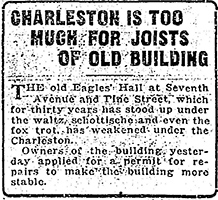
Thu, Mar 04, 1926 Seattle Times p. 15
Farewell Dance
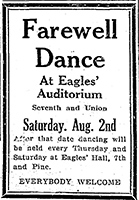
Fri, Aug 01, 1924 Seattle Times p. 3
Workman Dies In Collapse
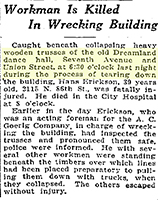
Thu, Aug 21, 1924 Seattle Times p. 26
Asians Plan Eagle Boycott
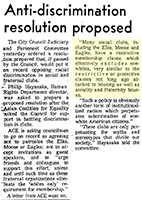
Wed, Oct 07, 1970 Seattle Times p. 25
Examination of Discrimination
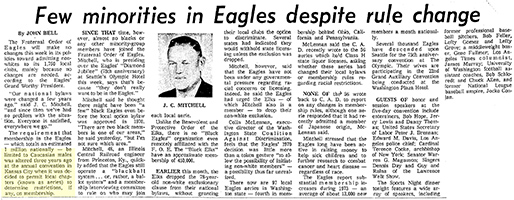
Wed, Aug 01, 1973 Seattle Times p. 73
Current Building
The current beautiful terra cotta structure was designed by Harry Bittman, who designed a number of important buildings around Seattle, including the King County
Courthouse and the Terminal Sales Building. There is an unattributed quote from Then and Now which says
A modification of Italian Renaissance, sufficiently ornamented to add to its beauty, without being ostentatious
A sketch of the original design is available, and it shows a bit more ostenatious facade. When built, the building was intended to house a 3,000 person
hall, smoking and reading rooms, restaurant, gym, bowling alley and billiard room. The anticipated cost was $1,000,000 (about 15 million of today's doillars)
and construction began in 1924, with the cornerstone being laid on 2/22/1925. Over 12,000 people attended the cornerstone ceremony, which was presided
over by Washington Governor Roland H. Hartley.
Grand opening was just 5 months later, July 16, 1925, and the official dedication was on September 27 of that year. Of course, there were
cost overruns, and the final bill was $1,180,985 - about a 20% overrun. It's also interesting to note that the total cost of property acquisition was $106,200.
The building was deemed sufficiently important that when the builder, Colin Hastie, died in 1936, it warranted a nice obiturary in the Seattle Times.
The building was an immediate sensation, as it provided the largest indoor gathering space in the city. But barely had it opened when Vice President Dawes spoke, and
crowds flowed into the streets. That was enough to stir up the motivation for a second, larger auditorium - and one owned by the city, to capture rental revenues.
The Civic Auditorium, as it was called, was a direct challenge to the ability of the Eagles to generate enough rent to pay the mortage. Of course they were irate,
ultimately forcing a public referendum. The Eagles lost, and the Civic Auditorium is what we now call the Center House, nearby the Space Needle. But Eagles had a
better location, and the two facilities seemed to have been independently successful. When Eagles Auditorium became a successful rock venue in the 1960s, Civic
Auditorium was able to offer a larger space, leading to bad blood. As a result, the biggest rock stars, like Seattle's own Jimi Hendrix, never played at Eagles Auditorium.
Membership Drive
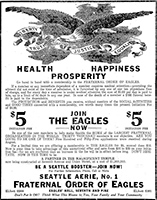
Fri, Sep 05, 1924 Seattle Times p. 19
Original Design
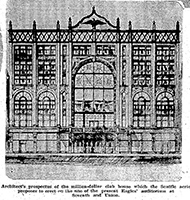
Sun, Feb 18, 1923 Seattle Times p. 67
Decorated For Eagles Convention
Modern Era
After construction, the first big change for Eagles Auditorium after construction was when I-5 cut Seattle in half.
There is a long, complex and interesting history about that project, but for Eagles Auditorium, it meant tearing down its neighbors and isolating it.
By the time I-5 was complete, Eagles Auditorium sat along, like a decorated wedding cake in a sea of asphalt. But development tore on.
The next step was the construction of the Washington State Convention Center (WSCC), which enveloped the back side of the building, but did provide easy, weatherproof access to parking.
There was controversy because the contruction of the WSCC doomed 137 low-income housing units in the area. Ultimately, CHG International, then
the owner of the building, agreed to provide 40 units of low-income housing in Eagles Auditorium. CHG declared bankruptcy in December of
1984, while design for WSCC was underway.
Paschen Cnstruction purchased the property in 1988, and plans were still pretty loose about what was going to happen there.
And finally, when ACT purchased and renovated the property in 1996, the most recent major changes were complete.
When looking at the photos of these strange versions of a semi-modern downtown, I've found it's helpful to focus on Town Hall (with the circular dome),
then directly across from it, the 3 columns of the building across the street. Continue on a few blocks, and you'll find Eagles.
After I-5, Before Freeway Park
Low-Income Housing Issue
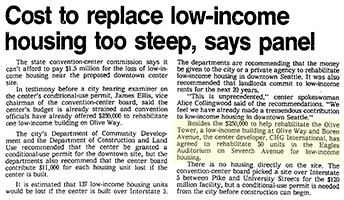
Tue, Jul 17, 1984 Seattle Times p. 22
Landmark Status
The developer CHG International owned Eagles Auditorium in the early 80s, and applied for landmark status in 1983. The application reads as
a lovely introduction to both the building and to the Fraternal Order of Eagles. The applicatioan was successful, and Eagles Auditorium was listed on the
National Register of Historic Places (NRHP) on July 14, 1983.
Application for Historic Registry (PDF)